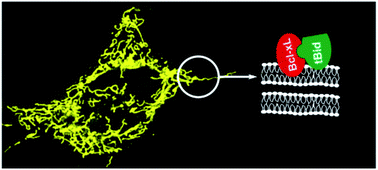Bcl-xL inhibits tBid and Bax via distinct mechanisms†
Abstract
The proteins of the Bcl-2 family are key regulators of apoptosis. They form a complex interaction network in the cytosol and in cellular membranes, whose outcome determines mitochondrial permeabilization and commitment to death. However, we still do not understand how the action of the different family members is orchestrated to regulate apoptosis. Here, we combined quantitative analysis of the interactions and the localization dynamics of the family representatives Bcl-xL, Bax and tBid, in living cells. We discovered that Bax and tBid are able to constitutively shuttle between cytosol and mitochondria in the absence of other Bcl-2 proteins. Bcl-xL clearly stabilized tBid at mitochondria, where they formed tight complexes. In contrast, Bcl-xL promoted Bax retrotranslocation to the cytosol without affecting its shuttling rate, but by forming weak inhibitory mitochondrial complexes. Furthermore, analysis of phospho-mimetics of Bcl-xL suggested that phosphorylation regulates the function of Bcl-xL via multiple mechanisms. Altogether, our findings support a model in which the Bcl-2 network not only modulates protein/protein interactions among the family members, but also their respective intracellular localization dynamics, to regulate apoptosis.

- This article is part of the themed collection: Peptide-membrane interactions


 Please wait while we load your content...
Please wait while we load your content...